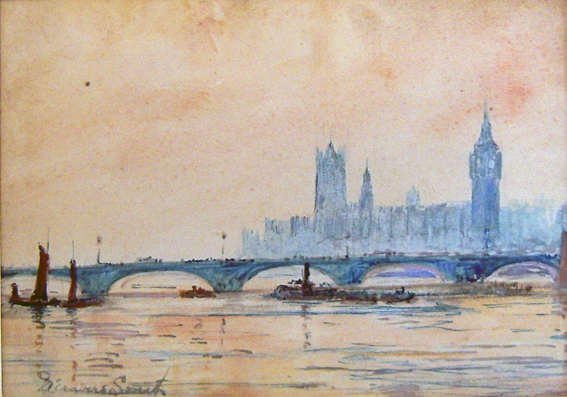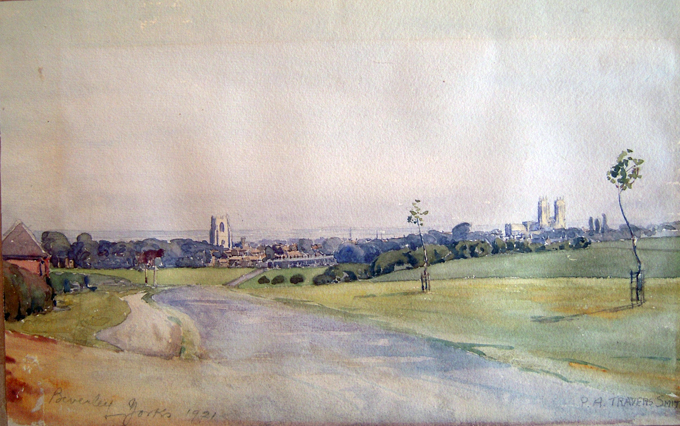These two paintings are by Peter (Pierre) Travers-Smith, my mother’s uncle and the father of Meryl Travers-Smith whose grave I visited in Hobart last year.
After I posted a previous blog about that visit, I was contacted by Chris from Melbourne who was trying to trace Meryl’s family.
His mother had been given these two paintings by Meryl who was a friend of hers in Hobart. Now he wanted to return them, on his mother’s behalf, to Meryl’s family; did I know who to contact? Well, I may not be the closest relative in terms of kinship (Meryl was my mother’s cousin, so I don’t know what that makes me in relation to her. She also had several nieces living in England) but I am certainly the nearest geographically speaking.
After discussing it with my mother, who was very close to Meryl, it was decided that I was in the best position of anybody to reclaim the paintings on behalf of the family and so, earlier this year, I travelled down to Melbourne to collect them.
I was intrigued and excited at the prospect of seeing the paintings. Peter Travers-Smith was well-known in the family for his artistic abilities. One of his paintings is at my parent’s house, a beautiful scene of Mount Wellington in Hobart. He painted a number of other landscapes of Tasmania, having arrived there as a refugee from China after WWII. There are also several paintings of the Weihsien internment camp in Shantung province where he was held captive by the Japanese during WWII along with his wife, Hilda, and daughter Meryl.
Hilda and Peter had known each other since childhood, their two families travelling out to China together in 1905 when Hilda was 13 years old. This is how my grandmother, Hilda’s sister, described the voyage out on the boat:
The 1st and 2nd class decks were only divided by railings, so we could see all that went on, & were very interested in all the wealthy people on board. Friends of ours, the Travers-Smiths, were travelling 1st class, & used to ask us over to see them.
Later on, the two families had adjoining houses at Pei Tai Ho, a resort town much-favoured by Westerners in that part of China during the hot summer months. By this time, Peter was regarded as Hilda’s boyfriend, according to my grandmother’s account, and the two sets of children became inseparable:
As they were not at the sea front they shared our piece of beach, so we had some riotous bathes, often by moonlight. One of our spots of fun was to go down to the beach after dark with lights, when the sand was covered with crabs, & tried catching them, but as soon as they saw the lights they disappeared into the sand, so we had to wait for them to come out again.
We always went to bathe either before breakfast or in the cool of the evening, as it was too hot during the day, & not safe to be out without hats. But we spent many hours on the sands otherwise, sunbathing in bathing suits, or very little on! We all learned to swim as children, & spent many hours in the sea.
Later still, after my grandmother’s family returned to England, Hilda travelled back out to China again where she married Peter. I’m not sure what they did during the years they lived there. My only remaining object from that period is a small silver box that came to me after Meryl’s death which carries the inscription: Presented to Mr & Mrs PA Travers-Smith from their friends at the Mines 1924-36.
*
I had a busy day in Melbourne, including driving out to Maryborough in the morning, so it was late afternoon by the time I made it to Chris’s house. It was my final stop for the day and I was looking forward to seeing the paintings.
It was a strange moment sitting there in Chris’s living room seeing them for the first time. I didn’t know the artist personally and I only met Meryl once, and yet it was hard to ignore the sense of a homecoming, the rediscovery of something that belonged. Something that mattered. So many of the things we own don’t really matter at all, or very little, but somehow it felt important to me to be able to bring the paintings home safely.
They are really just pieces in a puzzle. They don’t tell the complete story but, like the diaries and the photographs, help to fill in some of the detail. And like the scrawl of my great great grandmother’s handwriting in her diaries, the paintings speak of a real person, a hand that moved across the surface of the paper, an eye that looked, a human who felt.
This is about recovery, as in recovering that which might otherwise be lost. Does it matter if it is lost? Not really, in the scheme of things, but that doesn’t mean we should be negligent or dismissive about preserving what remains.
Maybe, too, it only really matters to me because I’m getting older.
The smaller of the two paintings is of a well-known view across the Thames looking towards Big Ben and Westminster Palace. It looks like it might be a combination of pastel and ink, sketched quite hurriedly in situ. It is not dated in the same way as Peter’s other paintings but it may possibly be from 1920.
It is a scene reminiscent of other more famous works such as Monet’s Houses of Parliament series from 1900-05 and a Winslow Homer water colour of almost exactly the same scene in 1881.
The larger water colour painting is more recognisably in Peter’s style. There is a certain delicacy and detail about his landscapes, and a stillness as “When in the east the morning ray/Hangs out the colours of the day”. It is as if everything has paused to take a breath, the shadows starting to shorten but the world still fresh and new.
It is a view of the market town of Beverley in Yorkshire, painted in 1921, according to the inscription. My mother’s family – Peter’s in-laws – came from this part of Yorkshire so it is possible that he (and perhaps Meryl too, who would have been about six years old at the time) were visiting them.
It is curious how the loops of time and place curve and intersect – from China to Yorkshire, from Yorkshire to Australia across several decades and different generations. As mentioned, I didn’t know Peter, and I knew Meryl only briefly towards the end of her life. And yet, these paintings are precious to me, not because they have any commercial value, but because of the connection they signify, the family narrative that flickers like tiny flames in the darkness to show the way.
I can’t overstate my gratitude to Chris for taking the time and making the effort to look after the paintings and track me down. I know he was fulfilling his mother’s wishes and I am very thankful that he took that task seriously and saw it through to the end. All good karma to him and his family.



I have painting by pa travers smith of Blinking Billy Point Sandy Bay
I have a P A Travers Smith painting entitled ‘Watch tower, in Japanese Concentration Camp, North China’ donated to the College several years ago by a student. I am trying to trace the student so that when I have the painting re-framed I can include their name on it. Apparently the artist was the student’s grandfather.
Any information would be appreciated.
Hi,
I have a painting of Elizabeth St pier in Hobart. I found this story whilst searching the name.
I believe my father , Percy Walter Alan Westwood may have been at school with Peter in Shanghai, a school for European boys called Cheefoo. He enrolled there in 1913. He had a love if these paintings and bought three, one of naval vessels at harbouf at Shanghai, one of Mt Roland and one of moonlight8xh37 on the Derwent.
That’s interesting. Do you still have the paintings? I’d be very interested to see them if you have. At some point I’d like to put together an online collection of his work as I reckon there are more paintings out there which would be worth sharing.
Hello, This is Elisabeth, Marjorie’s granddaughter. You must be one of June and John’s son’s? (Just seen below – hello Simon!) I have some PTS paintings I could send you pictures of if you are interested? My husband found your site searching him up. It’s been interesting to read! So you live in Australia?